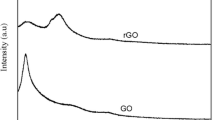Abstract
The graphite oxide (GO) was prepared based on the modified Hummers method, then reacted with zinc acetate aqueous, sodium hydroxide aqueous and hydrazine hydrate, and was doped into ZnO eventually to form graphene doped ZnO, an alternative transparent conducting oxide (TCO) for solar cell applications. The samples were characterized by Raman spectrometer, X-ray diffractometer, Fourier transform infrared spectroscopy and scanning electron microscope, and compared with widely used aluminum doped ZnO (AZO) in resistivity and transmissivity. The results show that the transmissivity of graphene doped ZnO reaches the same level as that of AZO in visible light band. In ultraviolet light wave band, the transmissivity of graphene doped ZnO reaches as high as 50%, exceeding that of AZO which is only 20%. The resistivity of optimized graphene doped ZnO is 1.03 × 10−5 Ω · m, approaching AZO resistivity which is about 10−4–10−6 Ω ·m. As a result, graphene doped ZnO may have potential applications in the area of TCO due to its low cost and high performance.
Similar content being viewed by others
References
Novoselov K S, Geim A K, Morozov S V, et al. Electric field effect in atomically thin carbon films [J]. Science, 2004, 306: 666–669.
Mccann E, Abergel D S L, Fal’ko V I. Electrons in bilayer grapheme [J]. Solid State Communications, 2007, 143: 110–115.
Bae S K, Kim H K, Lee Y B, et al. Roll-to-roll production of 30-inch graphene films for transparent electrodes [J]. Nature Nanotechnology, 2010, 5(18): 574–578
Tung V C, Allen M J, Yang Y, et al. Highthroughput solution processing of large-scale graphene [J]. Nature Nanotechnology, 2009, 4(1): 25–29.
Muszynski R, Seger B, Kamat P V. Decorating graphene sheets with gold nanoparticles [J]. The Journal of Physical Chemistry Letters C, 2008, 112: 5263–5266.
Lee J M, Pyun Y B, Yi J, et al. ZnO nanorod—graphene hybrid architectures for multifunctional conductors[ J]. The Journal of Physical Chemistry Letters C, 2009, 113: 19134–19138.
Wan Q, Li Q H, Chen Y J, et al. Fabrication and ethanol sensing characteristics of ZnO nanowire gas sensors [J]. Applied Physics Letters, 2004, 84(18): 3654–3657.
Zhang Y, Li H, Pan L, et al. Capacitive behavior of grapheme—ZnO composite film for supercapacitors [J]. Journal of Electroanalytical Chemistry, 2009, 634: 68–71.
Lu T, Zhang Y, Li H, et al. Electrochemical behaviors of graphene-ZnO and graphene-SnO2 composite films for supercapacitors [J]. Journal of Electroanalytical Chemistry, 2010, 55: 4170–4173.
Jézéquel D, Guenot J, Jouini N, et al. Submicrometer zinc oxide particles: Elaboration in polyo lmedium and morphological characteristics [J]. Journal of Materials Research, 1995, 10(1): 77–83.
Park S, An J, Piner R D, et al. Aqueous suspension and characterizationof chemically modified graphene sheets [J]. Chemistry of Materials, 2008, 20(21): 6592–6594.
Hummers W S, Offeman R E. Preparation of graphitic oxide [J]. Journal of the American Chemical Society, 1958, 80: 1339–1342.
Xu C, Wang X, Zhu J. Graphene: Metal particle nanocomposites [J]. The Journal of Physical Chemistry Letters C, 2008, 12: 19841–19845.
Cai D, Song M. Preparation of fully exfoliated graphite oxide nanoplatelets in organic solvents [J]. Journal of Materials Chemistry, 2007, 17: 3678–3680.
Herrera-Alonso M, Abdala A A, Mcallister M J, et al. Intercalation and stitching of graphite oxide with diaminoalkanes [J]. Langmuir, 2007, 23(21): 10644–10649.
Ferrari A C, Meyer J C, Scardaci V, et al. The Raman fingerprint of graphene [J]. Physical Review Letters, 2006, 97: 187401–187406.
Author information
Authors and Affiliations
Corresponding author
Additional information
Foundation item: the Natural Science Foundation of Shanghai (No. 13ZR1428200), and the National Project of University of Shanghai for Science and Technology (No. 14XPM06)
Rights and permissions
About this article
Cite this article
Li, Pp., Men, Cl., Li, Zp. et al. Study of graphene doped zinc oxide nanocomposite as transparent conducting oxide electrodes for solar cell applications. J. Shanghai Jiaotong Univ. (Sci.) 19, 378–384 (2014). https://doi.org/10.1007/s12204-014-1512-8
Received:
Published:
Issue Date:
DOI: https://doi.org/10.1007/s12204-014-1512-8




